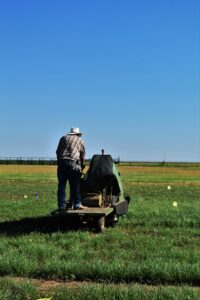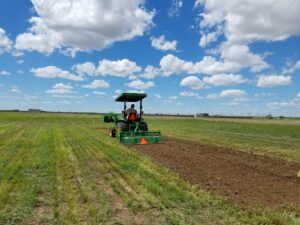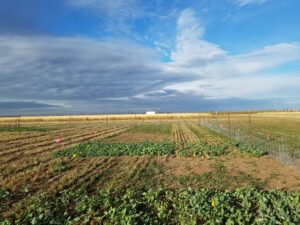2017 Annual Report for GS15-152
Evaluation of winter annual cover crops under multiple residue managements: Impacts on land management, soil water depletion, and cash crop productivity.
Summary
The imminent depletion of the Ogallala Aquifer demands innovative cropping alternatives to prevent dramatic losses of income when water levels are insufficient for irrigated row-crop production in the Southern High Plains. Integrating winter cover crops with summer crops maximizes land productivity and system profitability by improving water infiltration, stabilizing soils, and increasing potential income channels. Even though the benefits of cover crops for nutrient retention and erosion control are well recognized, adoption has been slow because of concerns that cover crops withdraw soil water to the detriment of the summer crop. This small-plot experiment is testing the interactive effects of irrigation and tillage management techniques with five cover-crop species on soil water depletion and productivity of the cover and subsequent summer forage crop. The overall aim is to compare the success of residue management schemes in reducing irrigation needs for the water-limited Southern High Plains region.
Data collection has included photographically monitoring ground cover of the cover crops, quantifying plant canopy characteristics and biomass, monitoring soil water depletion, and evaluating the impact on the summer teff hay crop. After the experiment is completed, research conclusions will be compiled into fact sheets readily available to producers through the Texas Alliance for Water Conservation (TAWC) annual Water College and electronic media, and to be distributed and demonstrated at TAWC and TTU Research Field Days. The impact of this project is two-fold: strengthen rural communities by ensuring the persistence of profitable agriculture in the region, and stabilizing the soil surface from excessive wind erosion and desiccation.
Objectives/Performance Targets
- Compare persistence and productivity of five winter cover crop species under four water and tillage treatment combinations for ability to conserve soil water and promote growth of summer forage.
- Compare residual effects of cover crops and winter management strategies on the productivity and nutrient status of a subsequent no-till, irrigated summer teff hay crop. Potential effects include nitrogen supplied by legumes, allelopathy from wheat and rye, and depletion of ground water resources.
- Compile research conclusions into fact sheets readily available to producers through the TAWC outreach program and to be demonstrated at Texas Tech Research Field Days.
Accomplishments/Milestones
- Weekly soil volumetric water content readings were made with a capacitance probe.
- Winter cover crops were harvested on April 22, 2016. Soil samples were collected from the top 10 inches in six random locations per irrigation x block combination to determine water status.
- We terminated winter cover crops in late April and early May by mowing close to ground. Teff was planted into stubble on May 19, 2016 with a Tye drill.
- The teff was irrigated to supplement rainfall up to 5 inches per month of total water (rain + irrigation) delivery. In total, 11.7 inches were applied to the teff crop (May 19 to September 6, 2016).
- Two harvests were made on the teff plots (July 19 and September 6, 2016).
- The teff stand was terminated by spraying glyphosate and mowing in early September 2016. Designated subplots were lightly disked prior to planting. All winter annual cover crops were planted using a tye drill on September 12 and 13, 2016.
- After planting, soil samples were again collected from the top 10 inches in six random locations per irrigation x tillage x block combination to determine water status.
- Irrigation has been applied to supplement rainfall up to no more than 1 inch per month of total water (rain + irrigation) delivery. Plots have received no more than 3.5 inches of irrigation since September 2016.
- One biomass harvest has already been taken from the rye and wheat plots in March 2017. Extent of nodulation (for burr medic and hairy vetch, on a 1-5 visual scale) within each plot, soil water status, and final biomass harvests will be completed at the end of April 2017.

Harvesting teff in Summer 2016

Preparing plots for planting winter cover crops in Fall 2016
Impacts and Contributions/Outcomes
The impact of this project is two-fold: strengthen rural communities by ensuring the persistence of agriculture in the region, and stabilizing the soil surface from excessive wind erosion and desiccation. Cattle production is crucial to the region’s agriculture community (Butler and Muir, 2012). This research can help rejuvenate the region’s ranching heritage but do so by promoting forage-based livestock systems that are potentially more productive and profitable than traditional rangelands, and more water-frugal when integrated into a row-crop dominant ecosystem. Texas plays a major role in agriculture, especially in the beef industry since the state had 12.4% of the nation’s cattle in 2014 (NCBA, 2015). Without the adoption of more sustainable, resource-efficient management practices, agriculture cannot persist on the Southern High Plains.
Outcomes from Year 1 of the experiment were presented in a poster session at the American Forage and Grassland Council’s Annual Conference in Roanoke, VA in January 2017. Preliminary conclusions include:
- Cover crops did not deplete available soil water.
- If the goal is to provide winter grazing and irrigation is available, rape-kale or rye is the best option.
- If the goal is to provide winter grazing and irrigation is not available, rape-kale is the best option.
- Rape-kale did reduce yield of the teff crop due to incomplete spring kill.
- Therefore, rye was the best overall option for supplying winter growth without reducing soil moisture reserves or yield of the following cash crop.

Competition from rape-kale limited teff yield in summer 2016

Winter cover crops in November 2016
Collaborators:
Professor
Texas Tech University
Plant and Soil Science
LUBBOCK, TX 79409
Office Phone: 8068344160